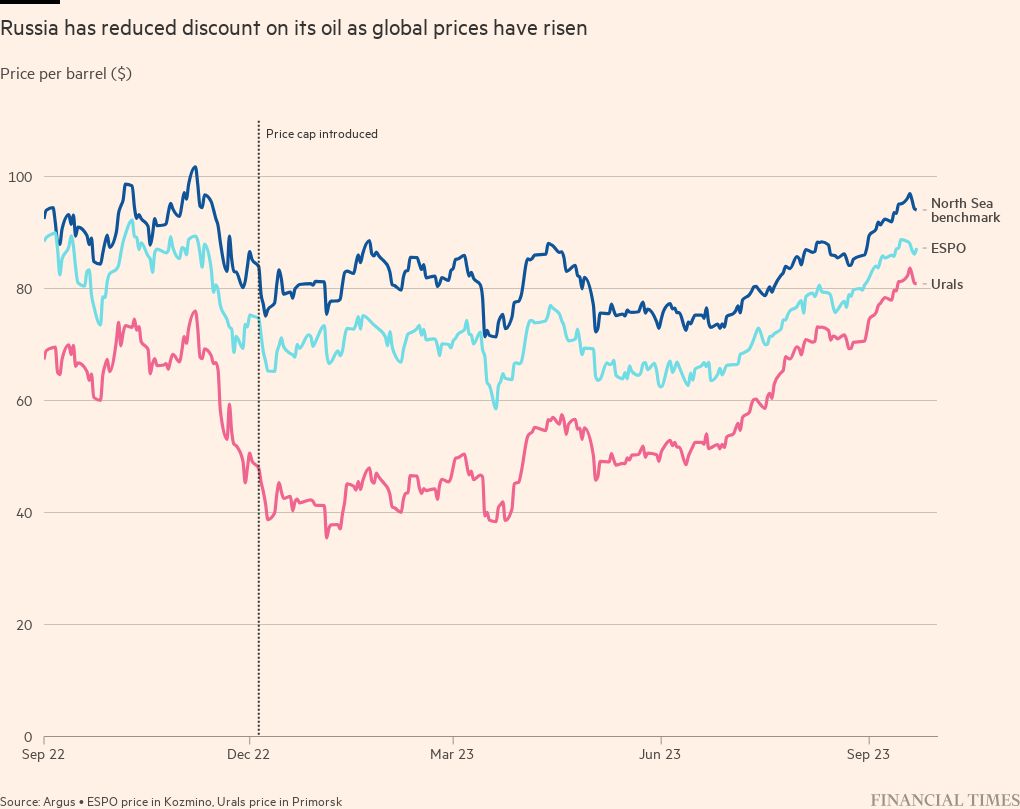Receive free Russian business & finance updates
We’ll send you a myFT Daily Digest email rounding up the latest Russian business & finance news every morning.
Russia has succeeded in avoiding G7 sanctions on most of its oil exports, a shift in trade flows that will boost the Kremlin’s revenues as crude rises towards $100 a barrel.
Almost three-quarters of all seaborne Russian crude flows travelled without western insurance in August, a lever used to enforce the G7’s $60-a-barrel oil price cap, according to an analysis of shipping and insurance records by the Financial Times.
That is up from about 50 per cent this spring, according to data from freight analytics company Kpler and insurance companies. The rise implies that Moscow is becoming more adept at circumventing the cap, allowing it to sell more of its oil at prices closer to international market rates.
The Kyiv School of Economics (KSE) has estimated that the steady increase in crude prices since July, combined with Russia’s success in reducing the discount on its own oil, means that the country’s oil revenues are likely to be at least $15bn higher for 2023 than they would have been.
The shift is a double blow for western efforts to restrict Russia’s revenues from oil sales — which make up the biggest part of the Kremlin’s budget — following its full-scale invasion of Ukraine.
Not only is a higher proportion of Russian oil being sold outside the cap, but Moscow’s increasing independence as a seller has coincided with a strong rally in oil prices, which topped $95 a barrel for the first time in 13 months this week.
While Russia’s oil sector is still facing several significant challenges, including claims of shortages in its domestic refined fuels market and a dip in export volumes overall, the figures still suggest more oil revenues will be flowing into the Kremlin’s war chest.
Ben Hilgenstock, an economist at the KSE, said: “Given these shifts in how Russia ships its oil, it may be very difficult to meaningfully enforce the price cap in future. And that makes it even more regrettable that we did not do more to properly enforce it when we had more leverage.”
Russia this week banned the export of diesel and other fuels, a significant move from one of the biggest global sellers of diesel. The move has raised fears that Russian president Vladimir Putin is trying to disrupt the oil market as he did with natural gas, sparking last year’s energy crisis.
While the EU and US have largely barred imports of Russian oil, the G7 price cap was designed to keep Russian oil flowing into global markets. The aim was to prevent a squeeze on supplies and an economically and politically damaging jump in prices.
The provision of western services such as shipping or insurance is allowed under the price cap — but only if Russia’s oil is sold for less than $60 a barrel. With Russia once reliant on western services to get its oil to market, the G7 calculated that Moscow would have little choice but to comply.
When the G7 price cap was first implemented in December last year Russia’s oil initially fell to a steep discount to international prices of as much as $40 a barrel. Moscow had to offer the discounts as it scrambled to reroute millions of barrels once destined for Europe to new customers in Asia, while still being heavily reliant on western shipping services.
Academics at the KSE calculate that sanctions, restrictions and withdrawals from Russia have cost $100bn in oil export revenues since February 2022.
However, Russia has built up a so-called “dark fleet” of oil tankers able to operate without western insurance or other services.
This has allowed Moscow to obtain higher prices for its oil as the global market has tightened. The average price of Russia’s main export grade, Urals, has risen above $60 a barrel since July.
Part of the decline in western-backed shipping is likely a result of wariness on the part of shipowners and insurers, even if they receive so-called “attestations” that the oil they are transporting has been sold for less than $60 a barrel.
In May, Russia was exporting about 3mn barrels a day of Urals and ESPO crude by sea on a combination of vessels with western and non-western insurance.
That total fell to about 2.5mn b/d in August, with the decline coming from western-insured ships, which only carried 626,000 b/d that month — less than half the volume they transported in May.
The diesel export ban announced on Thursday may temporarily hit Russia’s revenues but could lead to it receiving higher prices for lower volumes.


